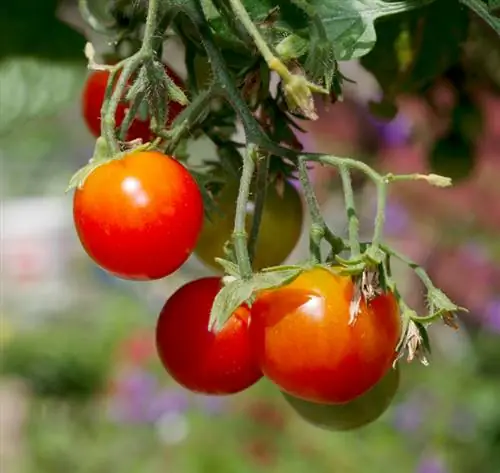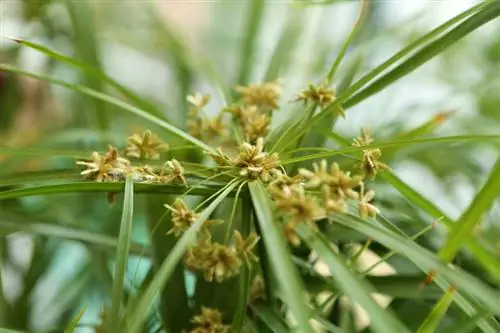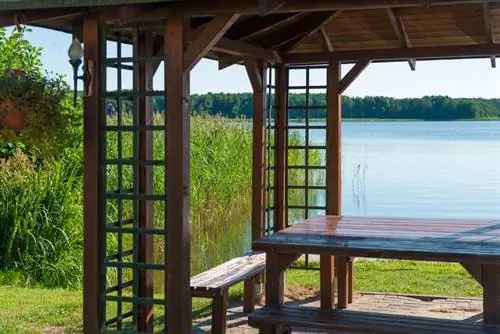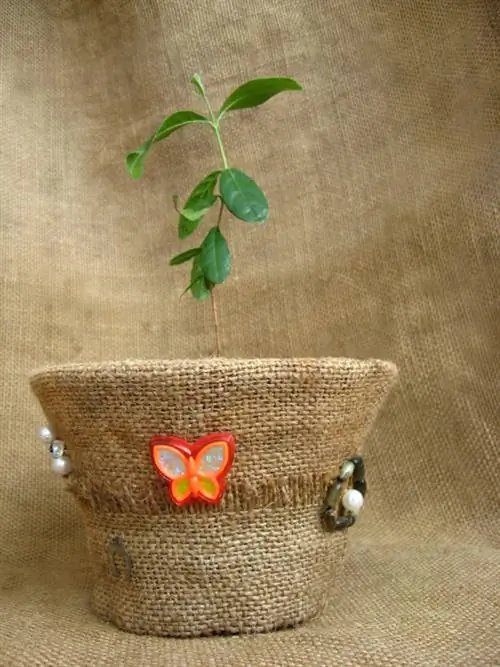- Author admin [email protected].
- Public 2023-12-16 16:46.
- Last modified 2025-01-23 11:20.
Pampas grass is an easy-care solitary tree. The main measures include cutting and fertilizing with compost in spring and proper wintering. This promotes flower formation in autumn.

How do you properly care for pampas grass?
Caring for pampas grass includes regular watering, fertilizing with compost in spring and cutting back to 15 cm high after the ice saints. The grass also needs a sunny to semi-shady location and should be protected from wind.
How to care for pampas grass?
Pampas grass care consists of fertilizing, watering and cutting. Fertilize with organic liquid fertilizer for ornamental grasses or compost after pruning in spring. In dry phases, the grass must be watered by hand, in a bucket when the substrate is dry. Pruning to a height of 15 cm is done in spring after the Ice Saints.
How do I care for pampas grass in the garden and container?
The ornamental grass needs the right care both in the garden and in the container to develop the shapely fronds and allow them to bloom. In addition to watering, fertilizing and pruning, this also includes overwintering and correctly planting the seedlings.
Planting pampas grass
Regardless of the form of cultivation, a species-appropriate location and appropriate soil conditions are essential for the he althy growth of the plant. The ideal planting time islate spring, when there is no longer any threat of ground frost. In practice, the timeafter the Ice Saints from mid-May has proven to be effective. You can find more tips on planting Cortaderia selloana here.
Location
The optimal location for the pampas grass is in asunny to partially shaded spot This should also be protected from direct weather influences such as wind and rain. The stalks of the plant react extremely sensitively to being bent over and cannot easily be straightened again afterwards. In practice, it has therefore proven useful to plant the ornamental grass near walls or fence elements, as these provide additional protection.

Cortaderia selloana only develops the impressive shape of its fronds in its entirety when the location is optimally chosen
Earth and soil conditions
The soil should ideally have adeep and humus-rich structure as well as a moderate nutrient density. A corresponding depth or permeability of the substrate can be achieved by adding sand or gravel.
Basically, it is recommended to align the pot or hole diameter with the size of the rootstock. A rule of thumb here is that it should be at least twice as big as the root ball. On the one hand, this saves you the work of frequent transplanting and, on the other hand, the additional stress on the plant.
The use of potting soil is not recommended due to the immense amount of nutrients it contains. The bamboo and grass soil from frux (€18.00 at Amazon) offers an optimal mixture, which ensures an even release of water and nutrients thanks to the natural clay it contains.
Bucket: The bottom ten centimeters of the bucket should be prepared as a drainage layer to enable optimal water drainage. The drainage layer should consist of expanded clay or gravel, which is then filled with grass soil or a homemade mixture of sand and soil.
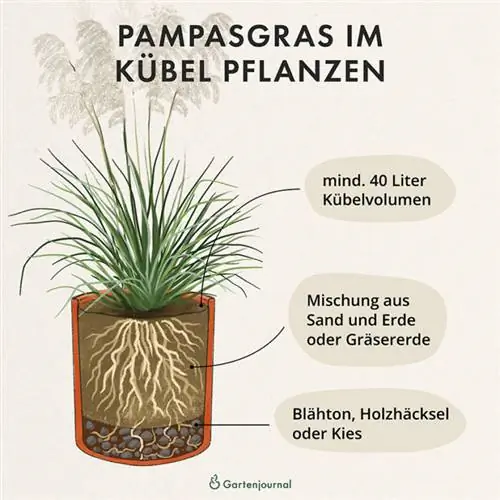
Beet: Due to its size, pampas grass should primarily be planted as a solitary plant. The plant, which can be up to three meters high, should be planted at a distance of at least one meter from other plants. Here too, it is recommended to create a drainage layer in the lower area of the planting hole.
Care for pampas grass
While the selection of the location and the substrate are one-time decisions, the care of the perennial requires ongoing continuity. There are a few tips to keep in mind, particularly with regard to irrigation, fertilization, pruning and wintering.
Water balance and watering
Due to the large amount of leaves, pampas grass offers a high evaporation surface. It is necessary to water the plant regularly, especially in the summer months. It is important to avoid completely drying out the root ball. At the same time, however, attention must be paid to waterlogging, which in turn promotes rotting processes on the roots. In the worst case, permanent overwatering will lead to the death of the plant.
It is therefore recommended to divide the amount of water intoseveral doses per week. To ensure the best possible water absorption, watering should be done either in the early morning or in the evening. You can quickly and easily determine the moisture content by taking a finger sample of the surrounding soil. As soon as the upper layers of soil have dried, you should water again.
Fertilizer
The pampas grass requires moderate fertilization to develop its impressive flower fronds. When budding begins in spring, a layer ofcompost should be spread and worked underground. The compost serves as a long-term fertilizer that continuously releases nutrients throughout the entire growing season. In order to keep the level at a stable level all year round, further fertilizer applications should be made continuously. However, you should not fertilize Cortaderia selloana more frequently than monthly to prevent over-fertilization.
The commercially available chemical fertilizers usually contain excessive amounts of nitrogen, which the plant responds to with spotty leaves and reduced flowering. You can read about which natural fertilizers are best suited alongside compost and how they are used here.
Cut back the plant and cut off the fronds
The ideal time for pruning is early spring, i.e. the timebetween March and April The dried stalks offer the sensitive plant heart natural frost protection over the winter. Additionally, additional moisture could penetrate the plant through the hollow stalks and damage it from the inside. In addition to cutting back completely, it may also be sufficient to simply brush out the pampas grass. You can find the most important information here.
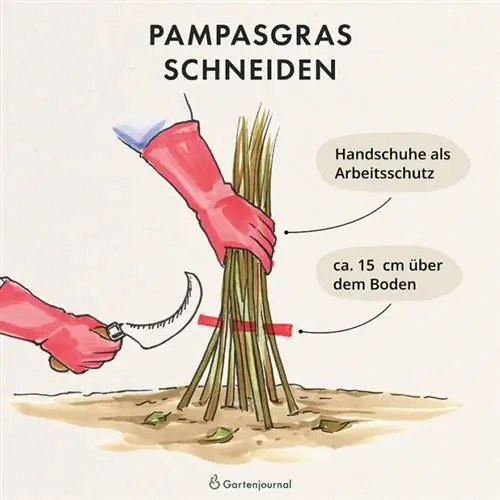
The trimming can take place according to the following scheme:
- wear robust gloves and work clothing to protect you from the sharp-edged leaves
- Tie the stalks together with a ribbon at a height of 30 centimeters
- Clean and disinfect secateurs for pruning
- Cut the stalks to a length of 15 centimeters
- leave out new green shoots
The fronds of Cortaderia selloana can be cut off in the fall before the actual flowering. As dried flowers they are particularly suitable for decorative use in vases.
However, it is important that simply cutting off the inflorescences would lead to the death of the remaining stalk. It is therefore advisable to cut off the entire stalk just above the ground.
Wintering
In this country, if planted early in the spring, pampas grass is hardy until the following frost period. However, the persistent moisture combined with the cold temperatures can cause damage to the plant. Separate winter protection can therefore still be useful.
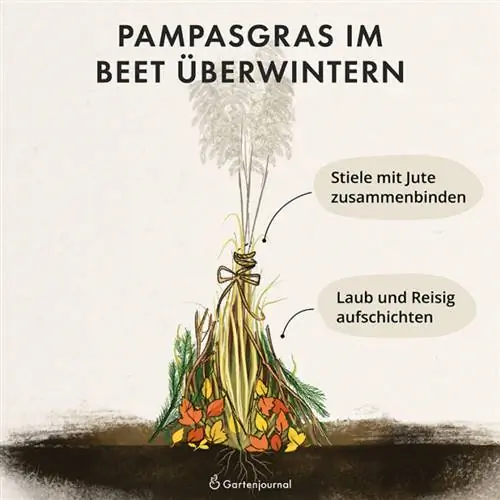
The remaining stems should be tied together with a thread to protect the heart of the plant. You can find more tips on this here. This prevents water from penetrating into the interior of the plant and also prevents the stalks from bending. In addition, the root area should be covered with brushwood, branches or leaves. These also repel large amounts of water and also protect the root area from icy winds.
However, potted plants need additional protective measures in order to survive the winter without any problems. You can find relevant information about wintering here.
Dried Pampas Grass Care
Dried pampas grass can be integrated into almost any living space - but only when dried. The magnificent flower fronds can be preserved in their shape for several years. To get your self-dried or purchased grass into shape, the following steps should be followed.
- shake individual stalks vigorously so that the loose fluff falls off
- Blow-dry the fronds into shape upside down on the cold setting
- Fix the flowers with hairspray until no more fluff falls out
In order to enjoy the dried flowers for as long as possible, they should always be kept away from water. This leads to the stalks becoming moldy, meaning they have to be disposed of. Detailed instructions for drying pampas grass can be found here.
FAQ
What is pampas grass?
Cortaderia selloana is a hardy ornamental grass that is particularly popular because of its impressive flower fronds. The main flowering period is from August to October. In addition, the stalks of pampas grass serve as a natural privacy screen.
Which soil is suitable for pampas grass?
To plant pampas grass, you can either use a homemade mixture of sand and soil or a ready-made mixture. However, due to the high requirements of the plant, a special grass soil is recommended. This has the required permeable structure and an appropriate nutrient density.
When to plant pampas grass?
To achieve complete winter hardiness until the next frost period, the ornamental grass should be planted in late spring. In order to avoid frost damage immediately after setting, the time after the ice saints, i.e. mid to late May, has proven to be useful in practice.
Which location is suitable for pampas grass?
Cortaderia selloana prefers a sunny and warm location. In addition, the selected location should be in a location protected from the weather.
How do I care for pampas grass?
The pampas grass should be both watered and fertilized moderately. Over- or under-supply can be easily determined based on the moisture content of the substrate and the plant's growth rate. In addition, the ornamental grass should be cut or combed out annually.



